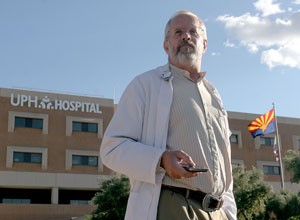Those long waits at the doctor’s office may soon become shorter.
More than a hundred new doctors will be trained by University Physicians Healthcare in coming years to help ease the current physician shortage in Arizona.
The UA is teaming up with UPH to create seven new residency programs that are expected to train 118 new doctors over the next three years.
The first of the programs – regarding internal medicine and psychiatry – will begin in July, with the radiology program beginning in the summer of 2009, said Katie Riley, associate director of community and media relations in the public affairs office at Arizona Health Sciences Center.
“”We’re all very excited about the new programs,”” said Victoria Murrain, UA assistant dean for graduate medical education.
Although the programs have just been accredited, ideas concerning the need for such a measure began in May 2006 when UPH established the need for residents to undergo additional training to address the physician shortage.
While medical school graduates in Arizona are on the rise, residents have been moving out of state to finish training, resulting in a mass exportation of medical residents, Murrain said.
Because most doctors settle down where they received training, the programs are intentionally designed to give medical residents in Arizona an opportunity to stay in state, she said.
With hospitals assuming the burden of the physician shortage, the effects have been passed down to the patients over the past several years, resulting in long appointment waits and the overworking of practicing doctors, she said.
“”We don’t know if the programs will fully alleviate the problem,”” Murrain said, “”but we at least want to make an impact for it.””
Only three of the programs are currently accredited, but Murrain is confident that the remaining four – emergency medicine, neurology, family medicine and ophthalmology – will be approved, she said.
The agreement between the UA and UPH is part of the Graduate Medical Education Consortium. The partnership is a cooperative effort that combines the established faculty of the university with the experience of the UPH staff, Murrain said.
While the UA and UPH are often competitors in the training of medical school graduates, the consortium was formed to put the institutions’ differences aside for the benefit of Arizona’s medical community, she said.
The programs are made possible by a sponsorship change, as Medicare has been unable to raise its budget for residents for several years, she said.
As the project is now sponsored by UPH and the UA, Medicare is specially allocating money for the training of new doctors, Murrain said.
“”UPH didn’t want to compete with the university,”” she said. “”We knew that we had to work together on this one since it’s such an important issue.””
The programs will also focus on providing adequate health care to rural and underserved areas, Riley said.
The goal to ease health care woes for the underprivileged is also being addressed by UPH in other current collaborations with the UA, like the Student Sight Savers Program that offers free glaucoma screenings to eligible Tucson residents.









